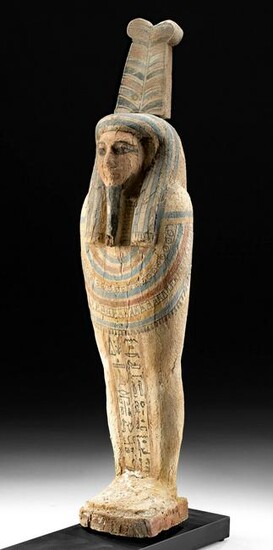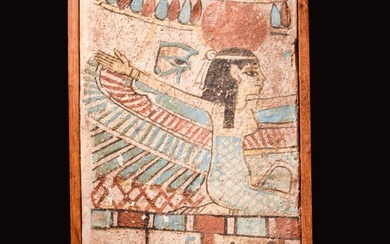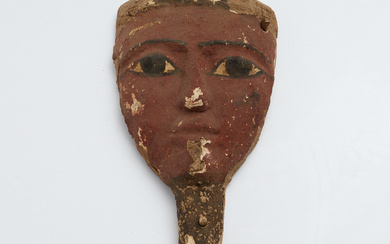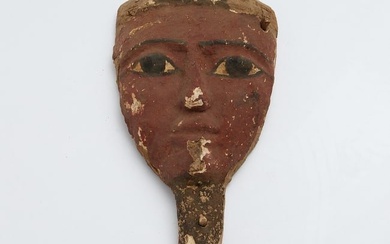Egyptian Wood / Polychrome Gesso Ptah Sokar Osiris
Ancient Egypt, Late Dynastic Period, 26th Dynasty, ca. 664 to 525 BCE. A gorgeous hand-carved wooden figure of Ptah-Sokar-Osiris, the synthesis between Ptah - the creator god of Memphis - as well as Sokar - the patron of the Memphis necropolis - and Osiris - the god of the afterlife and ruler of the underworld. Covered in layers of painted gesso, Ptah-Sokar-Osiris is shown standing in mummiform atop an integral trapezoidal plinth while peering outwards with ovoid eyes outlined in black. His flesh-hued face and black false beard stand out against the blue and yellow stripes of his tripartite wig, and his wesekh pectoral collar is adorned with semicircular rungs of beads, annular discs, and stripes in hues of blue, red, black, and yellow. Two columns of black hieroglyphs course down the front of the legs and, while untranslated, provide an offering incantation for the deceased. A modern pair of painted wood ostrich feathers - representing Ma'at or truth - is atop his head. Size: 5.25" W x 21.75" H (13.3 cm x 55.2 cm); 22.8" H (57.9 cm) on included custom stand.
Ptah Sokar Osiris is one of the most complicated concepts of Egyptian mythology. The figures shown here represents the god's three parts: Ptah, the creator god of Memphis; Sokar, the patron of the Memphite necropolis, and Osiris, the god of the afterlife and lord of the underworld. All three are traditionally depicted in mummy forms; Osiris and Ptah as men, and Sokar as a falcon. Sokar is no longer present in this example, but would have been present as a separate falcon effigy standing atop the original coffin-like box which this figure would have also stood upon. Together, they tell a story of birth, death, and resurrection. These figures became popular after ca. 1000 BCE and are associated with elite burials. In each, the god stands atop a box with a simple lid; a linen-wrapped mummy made of vegetable matter would be placed into the hollow box to represent rebirth in the afterlife (the earliest examples instead had funerary papyri placed inside of them). This "mummy" was a substitute image of the deceased, and when it sprouted, it would symbolize rebirth. The entire artifact, as this one once was, would be painted with rich colors, and decorated with hieroglyphics. Items like these were almost certainly made by priests as part of the funerary ritual. This figure represents the complex religious iconography of ancient Egypt and also serves as a good example that this religion and culture was not unchanging over the vast time period that it lasted; instead, new practices and gods arose over time.
Cf. examples from the Ptolemaic Period at The Metropolitan Museum of Art, accession number 21.9.1a-c; and the Art Institute of Chicago, reference number 2002.542
A similar example hammered for GBP 4,200 ($5,783.82) at Bonhams, London, New Bond Street "Antiquities" auction (May 1, 2008, lot 107); another similar example, without as much painted pigment but standing atop its original coffin box, hammered for GBP 5,000 ($6,885.95) at Christie's, London "Antiquities" auction (Live auction 14230, July 4, 2017, lot 155).
This piece has been searched against the Art Loss Register database and has been cleared. The Art Loss Register maintains the world's largest database of stolen art, collectibles, and antiques.
Provenance: ex-private Wilcox collection, Aurora, Colorado, USA, acquired in 1994; ex-Artemis Gallery
All items legal to buy/sell under U.S. Statute covering cultural patrimony Code 2600, CHAPTER 14, and are guaranteed to be as described or your money back.
A Certificate of Authenticity will accompany all winning bids.
PLEASE NOTE: Due to recent increases of shipments being seized by Australian & German customs (even for items with pre-UNESCO provenance), we will no longer ship most antiquities and ancient Chinese art to Australia & Germany. For categories of items that are acceptable to ship to Australia or Germany, please contact us directly or work with your local customs brokerage firm.
Display stands not described as included/custom in the item description are for photography purposes only and will not be included with the item upon shipping.
#167011
Condition Report: Painted wooden feather is a modern replacement of the original. Repair to proper bottom-left corner of feet, with chipping and light adhesive residue along break lines. Fissure to top of feet and ankles. Chipping and age-commensurate desiccation to painted gesso and wood, with touch-up painting along some painted areas as well as some hieroglyphs, expected fading to areas of original pigment, chipping to headdress, face, body, legs, and plinth, and minor inactive insect damage. Wonderful preservation to original pigment along upper half of body. Mortise drilled through bottom of feet for display purposes.
View it on
Sale price
Estimate
Time, Location
Auction House
Ancient Egypt, Late Dynastic Period, 26th Dynasty, ca. 664 to 525 BCE. A gorgeous hand-carved wooden figure of Ptah-Sokar-Osiris, the synthesis between Ptah - the creator god of Memphis - as well as Sokar - the patron of the Memphis necropolis - and Osiris - the god of the afterlife and ruler of the underworld. Covered in layers of painted gesso, Ptah-Sokar-Osiris is shown standing in mummiform atop an integral trapezoidal plinth while peering outwards with ovoid eyes outlined in black. His flesh-hued face and black false beard stand out against the blue and yellow stripes of his tripartite wig, and his wesekh pectoral collar is adorned with semicircular rungs of beads, annular discs, and stripes in hues of blue, red, black, and yellow. Two columns of black hieroglyphs course down the front of the legs and, while untranslated, provide an offering incantation for the deceased. A modern pair of painted wood ostrich feathers - representing Ma'at or truth - is atop his head. Size: 5.25" W x 21.75" H (13.3 cm x 55.2 cm); 22.8" H (57.9 cm) on included custom stand.
Ptah Sokar Osiris is one of the most complicated concepts of Egyptian mythology. The figures shown here represents the god's three parts: Ptah, the creator god of Memphis; Sokar, the patron of the Memphite necropolis, and Osiris, the god of the afterlife and lord of the underworld. All three are traditionally depicted in mummy forms; Osiris and Ptah as men, and Sokar as a falcon. Sokar is no longer present in this example, but would have been present as a separate falcon effigy standing atop the original coffin-like box which this figure would have also stood upon. Together, they tell a story of birth, death, and resurrection. These figures became popular after ca. 1000 BCE and are associated with elite burials. In each, the god stands atop a box with a simple lid; a linen-wrapped mummy made of vegetable matter would be placed into the hollow box to represent rebirth in the afterlife (the earliest examples instead had funerary papyri placed inside of them). This "mummy" was a substitute image of the deceased, and when it sprouted, it would symbolize rebirth. The entire artifact, as this one once was, would be painted with rich colors, and decorated with hieroglyphics. Items like these were almost certainly made by priests as part of the funerary ritual. This figure represents the complex religious iconography of ancient Egypt and also serves as a good example that this religion and culture was not unchanging over the vast time period that it lasted; instead, new practices and gods arose over time.
Cf. examples from the Ptolemaic Period at The Metropolitan Museum of Art, accession number 21.9.1a-c; and the Art Institute of Chicago, reference number 2002.542
A similar example hammered for GBP 4,200 ($5,783.82) at Bonhams, London, New Bond Street "Antiquities" auction (May 1, 2008, lot 107); another similar example, without as much painted pigment but standing atop its original coffin box, hammered for GBP 5,000 ($6,885.95) at Christie's, London "Antiquities" auction (Live auction 14230, July 4, 2017, lot 155).
This piece has been searched against the Art Loss Register database and has been cleared. The Art Loss Register maintains the world's largest database of stolen art, collectibles, and antiques.
Provenance: ex-private Wilcox collection, Aurora, Colorado, USA, acquired in 1994; ex-Artemis Gallery
All items legal to buy/sell under U.S. Statute covering cultural patrimony Code 2600, CHAPTER 14, and are guaranteed to be as described or your money back.
A Certificate of Authenticity will accompany all winning bids.
PLEASE NOTE: Due to recent increases of shipments being seized by Australian & German customs (even for items with pre-UNESCO provenance), we will no longer ship most antiquities and ancient Chinese art to Australia & Germany. For categories of items that are acceptable to ship to Australia or Germany, please contact us directly or work with your local customs brokerage firm.
Display stands not described as included/custom in the item description are for photography purposes only and will not be included with the item upon shipping.
#167011
Condition Report: Painted wooden feather is a modern replacement of the original. Repair to proper bottom-left corner of feet, with chipping and light adhesive residue along break lines. Fissure to top of feet and ankles. Chipping and age-commensurate desiccation to painted gesso and wood, with touch-up painting along some painted areas as well as some hieroglyphs, expected fading to areas of original pigment, chipping to headdress, face, body, legs, and plinth, and minor inactive insect damage. Wonderful preservation to original pigment along upper half of body. Mortise drilled through bottom of feet for display purposes.






